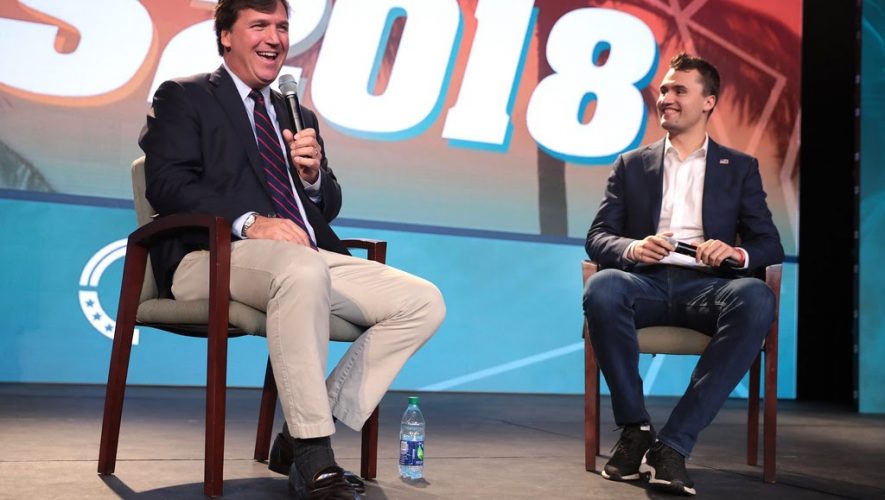Young adults in America are often referenced as a monolithic body—praised for their “generational awareness and generational solidarity,” “passion for making positive change,” and “revolutionizing activism.”
Sometimes the profiles present a less insurgent picture; Newsweek depicted Gen Z as a breed of cautious pessimists, shaped by their parents’ cynicism and volatile socioeconomic conditions.
Other portrayals are less flattering; Greg Lukianoff and Jonathan Haidt wrote a bestselling book about a mass movement of students working “to scrub campuses clean of words, ideas, and subjects that might cause discomfort or give offense.”
While certain Gen Z cohorts are emblematic of forward-thinking rebellion, measured pragmatism, or hypersensitivity, it is by no means a homogenous group. Gen Z’s outlooks are stratified, and political division is as prevalent among America’s youth as it is throughout the nation.
As a consequence, right-wing media voices have seized on this trend of polarization, employing propagandistic tactics to quickly infiltrate Zoomer circles. Conservative youth groups, podcasts, and commentators have grown their platforms exponentially, competing for audiences through mainstream social networks and niche media outlets. These “right-wing influencers” are using this unprecedented uptick in popularity to inculcate America’s young minds with ultranationalism and xenophobia.
When such dangerous rhetoric becomes accessible to impressionable young adults, the fallout has proven disastrous. Take, for example, Kyle Rittenhouse, the seventeen-year-old who shot and killed two people at a protest in Kenosha, Wisconsin. Before the shooting, Rittenhouse frequently touted support for Trump on his social media accounts, and was praised by right-wing commentators for “maintaining order” at the demonstration. The veneration of Rittenhouse in conservative circles does little to dissuade young people from carrying out violence in support of nationalist sentiments.
Contemporary right-wing media use a host of tactics to indoctrinate audiences and spin narratives in their favor—not limited to sloganeering social media pages, radio and television appearances rife with disinformation and reactionary sentiment, and a hard-line focus on the culture war. Let’s analyze a few key actors.
Conservatism on College Campuses
Conservative movements have historically taken root on college campuses, where “everyday routines and social networks are disrupted and need to be rebuilt.” As a result of this transition point in their lives—where there is heightened exposure to unorthodox ideologies—students are more susceptible to political mobilization campaigns.
While left-leaning factions remain the dominant force in campus civic life, right-wing organizations are playing a more visible role. College students increasingly align themselves with partisan groups or ideologies; young people have also demonstrated a proclivity towards political action and exerting political power.
Conservative students are more likely to feel marginalized by the political sentiments at their colleges and universities. For example, conservatives reportedly experience more pressure than liberals to align with their professors’ political leanings. And, while 87 percent of liberal students considered themselves to be “tolerant of other people’s beliefs,” only 68 percent of conservatives thought the same.
Right-wing student groups have capitalized on this trend of polarization and social stratification. Perhaps the most prominent of these organizations is Turning Point USA, which provides resources—including funding for rallies and student elections—to students who promote conservative values on campuses. The organization has over a million followers on Instagram, where it frequently posts flashy, sloganeering graphics with sentiments about the virtues of free-market economics, limited government, and the bane of cancel culture.
Beneath their relatively benign-sounding mission statement, Turning Point finances vast and influential campaigns of misinformation and alarmism backed by major Republican power brokers.
One noteworthy example of its activism is the “Professor Watchlist,” a website which categorizes purportedly controversial college professors as left-wing extremists. A number of voices in higher education have expressed concern that the site “could be used to harass professors or sabotage them from gaining jobs or promotions,” or even radicalize young students who feel marginalized in classrooms.
Turning Point is funded by major Republican donors and produces shady financial reports despite its non-profit status. The group’s founder, the enterprising twenty-seven-year-old Charlie Kirk, has been aggressive and unabashed in his support of President Trump. Kirk, who served as a personal aide to Donald Trump Jr. during the 2016 election, dubbed the president “the bodyguard of Western civilization” at the 2020 Republican National Convention. In addition to lavishing praise, Kirk circulates the president’s oft-repeated falsehoods and attack lines.
Kirk promotes conspiracy theories about COVID-19 cover-ups by China and alleged Democratic improprieties through his personal Twitter account, which has nearly two million followers. His social media presence is far from self-contained; President Trump has frequently shared content from Kirk and Turning Point to his eighty-seven million Twitter followers.
Furthermore, affiliates of Turning Point have promulgated the president’s messages through smaller-scale channels. In October, hundreds of Facebook and Instagram profiles supportive of Trump and other conservative initiatives were revealed to be fake accounts created by a marketing firm on behalf of the group. These pages were part of a broader effort to recruit teenagers for a “troll farm” working to spread disinformation.
Experts have detailed the dangerous consequences of exposure to Turning Point’s brand of misinformation. In fact, the Kremlin-backed Internet Research Agency employed Turning Point-created memes to sow discord in the 2016 election.
Gen Z has been shown to be particularly vulnerable to the polarizing effects of social media, as website algorithms connect users with content that reinforces their political views. As impressionable teenagers consume ever-increasing amounts of digital content, there is a heightened proclivity towards shaping and being shaped by rampant misinformation. Interests and actors on college campuses can disseminate misleading content, making it especially critical to recognize malicious efforts to sway young minds.
Right-Wingers on the Airwaves
Beyond the confines of social media, prominent right-wing media voices project their views through podcasts, YouTube streams, and radio broadcasts. While it can be difficult to convey substantive content on social media, long-form shows enable commentators to take deep dives into hot-button conservative issues.
Much like radio personalities—including the conservative icon Rush Limbaugh—fueled the rise of the “New Right” in the 1980s and 90s, a number of voices are ushering in a renaissance of right-wing propagandizing in the twenty-first century.
Among these figures is Ben Shapiro, the right-wing rabble-rouser who “turn[ed] the culture war into an entertainment product.” Shapiro founded the conservative news outlet The Daily Wire, which has more than 140 million page views monthly; he is perhaps more prominently recognized for his Internet and radio presence, with 2.2 million subscribers on his YouTube channel and a syndicated show. Shapiro’s audience leans young, and that ability to attract a youth audience has preserved his influence.
Shapiro has been hailed as an innovator and hero of young conservatives, having started his commentary career at age seventeen. He has been described as “the cool kid’s philosopher,” a spiritual successor to Rush Limbaugh. Shapiro’s fighting energy, overawing (and occasionally condescending) speech pattern, and “memeability” have propelled his ideological perspective—particularly a commitment to faith-based conservativism—to success.
His posts frequently make the rounds on social media, often reaching farther than left-leaning content. Shapiro primarily sets his sights on the culture war. For instance, Shapiro recorded a lengthy takedown of Cardi B’s “WAP,” deriding the track for its purportedly tasteless lyrics and hypersexual content—qualities he views as indicative of the feminist movement and women’s battle for equality. Some journalists noted that Shapiro’s comments sparked a “conservative crusade” against the song, validating a long-running trend of misogyny in alt-right spheres.
Shapiro indoctrinates young minds with a focus on irreverent rhetorical style in place of substantive policy objectives. Conservative youth groups routinely invite him to lecture on college campuses, which often spurs widespread backlash from students. His inflammatory appearance at Boston University drew hundreds of protestors and spawned petitions with thousands of signatures demanding that the institution ban Shapiro from campus. Shapiro leveraged the controversy for millions of clicks and views, posting videos where he “takes apart arguments in ways that makes the conservative conclusion seem utterly logical.”
By making appearances in mainstream forums, Shapiro and other hard-line, right-wing commentators legitimize their relatively radical viewpoints. Take, for instance, The Joe Rogan Experience, which routinely tops the podcast charts and paved the way for modern “podcast culture.” Rogan is no stranger to hosting right-wingers on his show—Shapiro’s two appearances alone total more than 18 million views. In granting a platform to such voices, Rogan’s ultra-popular format serves as a “gateway” to more radical content creators.
Research has demonstrated a link between established influencers like Rogan and far-right figures with brands built on hate speech. When these figures collaborate with mainstream creators, their viewers are more likely to be drawn into the so-called “Alternative Influence Network”—essentially the “dark side” of YouTube, where impressionable audiences are exposed to radical and controversial commentators via the site’s recommendation algorithms. Furthermore, Rogan’s audience is overwhelmingly young and male, spotlighting the potential for polarization within one of the country’s most suggestible demographics.
Others among Rogan’s gallery of garish right-wing guests are Tim Pool, the journalist-turned-podcaster who often speculates about an impending civil war; Jordan Peterson, the reactionary, anti-feminist Canadian psychologist who prostelytizes young men disaffected by social justice movements; Candace Owens, the Turning Point USA surrogate who once spoke favorably of Hitler’s nationalism; and the infamous Alex Jones of Infowars.
The Fallout (and Solutions)
Right-wingers use a plethora of audio, video, and internet strategies to recruit persuadable young minds into their movement, with destructive and diabolical outcomes. Alexandre Bissonnette, a terrorist who attacked a mosque in Quebec in 2017, incessantly examined conservative media including Ben Shapiro, whose Twitter account he viewed nearly one hundred times in the month before the fatal mass shooting.
Though these right-wing voices propagate their message on college campuses and the internet, they do not operate in a vacuum. Their ideology is stoked and disseminated by a plethora of special interests, dark money, and influential actors, including GOP financers, Russian propaganda outlets, YouTube algorithms, and the president. Their target is young people, whose views are formed and cemented on social media and through schools.
On a macro level, Millennials and Gen Z make up nearly 40 percent of the electorate, meaning their votes will play a significant role in every election for the next half-century. The inflammatory and energizing rhetoric of right-wing commentators could drive their audience to the polls, much like Trump’s bombastic personality spurred turnout among White men in 2016.
Besides the obvious and oft-repeated call to vote, it is important for citizens to consume a balanced diet of media. An abundance of left-wing voices exist in mainstream and offbeat channels, working tirelessly to counteract the misinformation propagated by certain right-wing outlets. While commentary inherently comes with bias, one must aim to avoid the risks created by ensnaring algorithms and social networks. It is up to the people to criticize such biased and prejudiced media, ultimately minimizing its impact on elections and policy.





